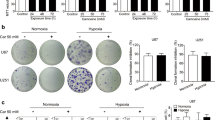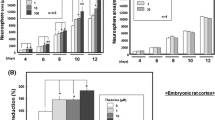Abstract
As one of the in vitro model experiments for investigating a possible effect of extracellular environmental stresses on glial cell proliferation, the influence of high salt culture conditions on the growth of rat C6 glioma cells was examined. Exposure to the culture medium containing high concentrations of NaCl reduced the number of viable cells in a concentration-dependent manner without any significant change in their viability. In contrast, proliferation of these cells was not substantially altered by culturing them in hyperosmotic medium containing either sucrose or glycerol, both of which were osmotically almost equivalent to high salt culture medium. On the other hand, expression of the egr-1 gene, an immediate early gene related to the proliferation and differentiation of various cells, was enhanced by culturing glioma cells in high salt medium while the reduction of glial fibrillary acidic protein content, an index of glial cell differentiation, was observed under the same culture conditions. Further studies on the relationship between egr-1 gene expression and the cell cycle showed that cell-cycle progression was arrested at S-phase by culturing glioma cells in high salt medium. Moreover, both resveratrol and CPT-11 (Irinotecan), which are known to arrest cell-cycle progression, elevated egr-1 mRNA levels in glioma cells. Thus, these observations suggest that high salt culture conditions might suppress the proliferation of rat C6 glioma cells as a consequence of arresting cell-cycle progression at S-phase, resulting secondarily in the compensatory enhancement of egr-1 gene expression.
Similar content being viewed by others
References
Beckmann A. M. and Wilce P. A. (1997) Egr transcription factors in the nervous system. Neurochem. Int. 31, 477–516.
Bova R., Micheli M. R., Qualadrucci P., and Zucconi G. G. (1998) BDNF and trkB mRNAs oscillate in rat brain during the light-dark cycle. Mol. Brain Res. 57, 321–324.
Bradford M. M. (1976) A rapid and sensitive method for the quantitation of microgram quantities of protein utilizing the principle of protein-dye binding. Anal. Biochem. 72, 248–254.
Castello L. and Tessitore L. (2005) Resveratrol inhibits cell cycle progression in U937 cells. Oncol. Rep. 13, 133–137.
Catania M. V., Copani A., Calogero A., Ragonese G. I., Condorelli D. F., and Nicoletti F. (1999) An enhanced expression of the immediate early gene, Egr-1, is associated with neuronal apoptosis in culture. Neuroscience 91, 1529–1538.
Chen Y., Tseng S. H., Lai H. S., and Chen W. J. (2004) Resveratrol-induced cellular apoptosis and cell cycle arrest in neuroblastoma cells and antitumor effects on neuroblastoma in mice. Surgery 136, 57–66.
Chomczynski P. and Sacchi N. (1987) Single-step method of RNA isolation by acid guanidinium thiocyanate-phenolchloroform extraction. Anal. Biochem. 162, 156–159.
Cohen D. M. (1996) Urea-inducible Egr-1 transcription in renal inner medullary collecting duct (mIMCD3) cells is mediated by extracellular signal-regulated kinase activation. Proc. Natl. Acad. Sci. U. S. A. 93, 11,242–11,247.
Cohen D. M., Chin W. W., and Gullans S. R. (1994) Hyperosmotic urea increases transcription and synthesis of Egr-1 in murine inner medullary collecting duct (mIMCD3) cells. J. Biol. Chem. 269, 25,865–25,870.
Cohen D. M., Wasserman J. C., and Gullans S. R. (1991) Immediate early gene and HSP70 expression in hyperosmotic stress in MDCK cells. Am. J. Physiol. 261, C594-C601.
Comer A. M., Yip S., and Lipski J. (1997) Detection of weakly expressed genes in the rostral ventrolateral medulla of the rat using micropunch and reverse transcription-polymerase chain reaction techniques. Clin. Exp. Pharmacol. Physiol. 24, 755–759.
Dey B. R., Sukhatme V. P., Roberts A. B., Sporn M. B., Rauscher F. I., and Kim S. J. (1994) Repression of the transforming growth factor-beta 1 gene by the Wilms’ tumor suppressor WT1 gene product. Mol. Endocrinol. 8, 595–602.
Fautz R., Husein B., and Hechenberger C. (1991) Application of the neutral red assay (NR assay) to monolayer cultures of primary hepatocytes: rapid colorimetric viability determination for the unscheduled DNA synthesis test (UDS). Mutat. Res. 253, 173–179.
Herdegen T. and Leah J. D. (1998) Inducible and constitutive transcription factors in the mammalian nervous system: control of gene expression by Jun, Fos and Krox, and CREB/ATF proteins. Brain Res. Rev. 28, 370–490.
Huang R. P., Fan Y., Ni Z., Mercola D., and Adamson E. D. (1997) Reciprocal modulation between Sp1 and Egr-1. J. Cell Biochem. 66, 489–499.
Koizumi F., Kanzawa F., Ueda Y., Koh Y., Tsukiyama S., Taguchi F., et al. (2004) Synergistic interaction between the EGFR tyrosine kinase inhibitor gefitinib (“Iressa”) and the DNA topoisomerase I inhibitor CPT-11 (irinotecan) in human colorectal cancer cells. Int. J. Cancer. 108, 464–472.
Krishnaraju K., Nguyen H. Q., Liebermann D. A., and Hoffman B. (1995) The zinc finger transcription factor Egr-1 potentiates macrophage differentiation of hematopoietic cells Mol. Cell. Biol. 15, 5499–5507.
Liu C., Rangnekar V., Adamson E., and Mercola D. (1998) Suppression of growth and transformation and induction of apoptosis by EGR-1. Cancer Gene Ther. 5, 3–28.
Ludwig M., Johnstone L. E., Neumann I., Landgraf R., and Russell J. A. (1997) Direct hypertonic stimulation of the rat supraoptic nucleus increases c-fos expression in glial cells rather than magnocellular neurons. Cell Tissue Res. 287, 79–90.
Magrini R., Bhonde M. R., Hanski M. L., Notter M., Scherubl H., Boland C. R., et al. (2002) Cellular effects of CPT-11 on colon carcinoma cells: dependence on p53 and hMLH1 status. Int. J. Cancer 101, 23–31.
McDonald A. C. and Brown R. (1998) Induction of p53-dependent and p53-independent cellular responses by topoisomerase 1 inhibitors. Br. J. Cancer 78, 745–751.
Milbrandt J. (1987) A nerve growth factor-induced gene encodes a possible transcriptional regulatory factor. Science 238, 797–799.
Morikawa M., Asai K., Kokubo M., Fujita K., Yoneda K., Yamamoto N., et al. (2001) Isolation and characterization of a new immortal rat astrocyte with a high expression of NGF mRNA. Neurosci. Res. 39, 205–212.
Morita K. and Wong D. L. (2000) Glucocorticoids enhance serum deprivation-but not calcium-induced cytotoxicity in rat C6 glioma cells. Cell Biol. Int. 24, 223–228.
Morita K., Ishimura K., Tsuruo Y., and Wong D. L. (1999a) Dexamethasone enhances serum deprivation-induced necrotic death of rat C6 glioma cells through activation of glucocorticoid receptors. Brain Res. 816, 309–316.
Morita K., Tsuruo Y., Ishimura K., Her S., Bell R. A. and Wong D. L. (1999b) Influence of serum-free culture conditions on steroid 5α-reductase mRNA expression in rat C6 glioma cells. Brain Res. 830, 179–182.
Nakagama H., Heinrich G., Pelletier J., and Housman D. E. (1995) Sequence and structural requirements for high-affinity DNA binding by the WT1 gene product. Mol. Cell. Biol. 15, 1489–1498.
Nguyen H. Q., Hoffman-Liebermann B., and Liebermann D. A. (1993) The zinc finger transcription factor Egr-1 is essential for and restricts differentiation along the macrophage lineage. Cell 72, 197–209.
Park J. W., Choi Y. J., Jang M. A., Lee Y. S., Jun D. Y., Suh S. I., et al. (2001) Chemopreventive agent resveratrol, a natural product derived from grapes, reversibly inhibits progression through S and G2 phases of the cell cycle in U937 cells. Cancer Lett. 163, 43–49.
Pignatelli M., Cortes-Canteli M., Santos A., and Perez-Castillo A. (1999) Involvement of the NGFI-A gene in the differentiation of neuroblastoma cells. FEBS Lett. 461, 37–42.
Pignatelli M., Luna-Medina R., Perez-Rendon A., Santos A., and Perez-Castillo A. (2003) The transcription factor early growth response factor-1 (EGR-1) promotes apoptosis of neuroblastoma cells. Biochem. J. 373, 739–746.
Quiñones A., Dobberrrstein K. U., and Rainov N. G. (2003) The egr-1 gene is induced by DNA-damaging agents and non-genotoxic drugs in both normal and neoplastic human cells. Life Sci. 72, 2975–2992.
Shin S. Y., Kim C. G., Hong D. D., Kim J. H., and Lee Y. H. (2004) Implication of Egr-1 in trifluoperazine-induced growth inhibition in human U87MG glioma cells. Exp. Mol. Med. 36, 380–386.
Shirsat N. V., Kayal J. J., Shaikh S., and Mehta A. (2001) Growth inhibition and differentiation of C6 glioma cells on treatment with HMBA. Cell. Biol. Int. 25, 621–627.
Thottassery J. V., Sun D., Zambetti G. P., Troutman A., Sukhatme V. P., Schuetz E. G., and Schuetz J. D. (1999) Sp1 and egr-1 have opposing effects on the regulation of the rat Pgp2/mdr1b gene. J. Biol. Chem. 274, 3199–3206.
Wollnik B., Kubisch C., Maass A., Vetter H., and Neyses L. (1993) Hyperosmotic stress induces immediate-early gene expression in ventricular adult cardiomyocytes. Biochem. Biophys. Res. Commun. 194, 642–646.
Ying Z., Reisman D., and Buggy J. (1996) AP-1 binding activity induced by hyperosmolality in the rat hypothalamic supraoptic and paraventricular nuclei. Mol. Brain Res. 39, 109–116.
Author information
Authors and Affiliations
Corresponding author
Rights and permissions
About this article
Cite this article
Arimochi, H., Morita, K. High salt culture conditions suppress proliferation of rat C6 glioma cell by arresting cell-cycle progression at S-phase. J Mol Neurosci 27, 293–302 (2005). https://doi.org/10.1385/JMN:27:3:293
Received:
Accepted:
Issue Date:
DOI: https://doi.org/10.1385/JMN:27:3:293




